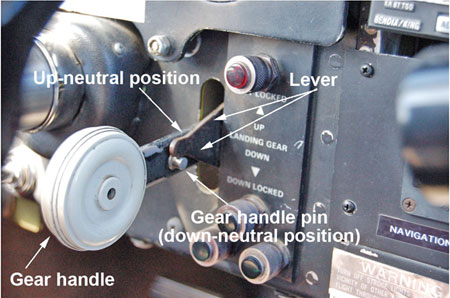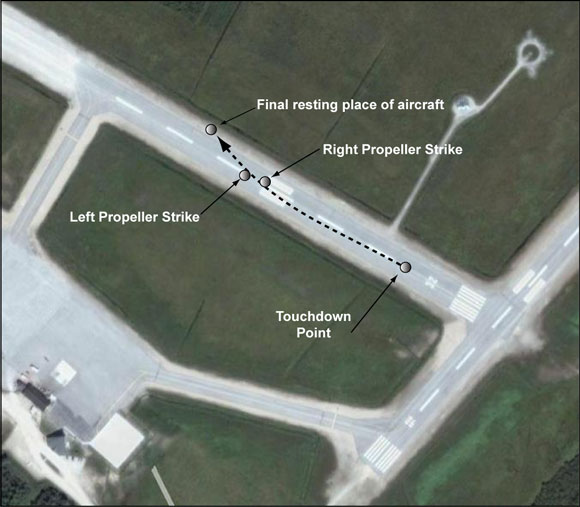Landing Gear Collapse After Touchdown
Wabusk Air
Piper PA31 C-GRVW
Moosonee, Ontario
The Transportation Safety Board of Canada (TSB) investigated this occurrence for the purpose of advancing transportation safety. It is not the function of the Board to assign fault or determine civil or criminal liability. This report is not created for use in the context of legal, disciplinary or other proceedings. See Ownership and use of content. Masculine pronouns and position titles may be used to signify all genders to comply with the Canadian Transportation Accident Investigation and Safety Board Act (S.C. 1989, c. 3).
Summary
The Wabusk Air Piper PA31 aircraft (registration C-GRVW, serial number 31-618) departed a private grass strip with a pilot and passenger on board for a short flight to the Cochrane Airport, Ontario, to pick up another passenger. After departing Cochrane, the pilot flew to Moosonee and conducted a visual flight rules approach for Runway 32. Approximately 1.5 nm from the runway, the pilot selected the landing gear down and confirmed that the landing gear was indicating down and locked. This was also verbally confirmed by the passenger, another company pilot, who was sitting in the right seat. The aircraft landed normally, and the pilot selected flaps up and boost pumps off. The pilot was about to apply brakes to slow down for taxiway Bravo when the gear horn sounded and the right main landing gear collapsed, followed quickly by the collapse of the left main and nose landing gear. The aircraft came to rest approximately 1550 feet from the threshold of Runway 32, just off the right side of the runway. There were no injuries.
Factual information
The accident occurred at about 1154 eastern daylight time, Footnote 1 in visual meteorological conditions.
The pilot held a commercial pilot licence (aeroplane). His category 1 medical certificate had expired, and he was exercising the privileges of a private pilot. As of April 2007, he had accumulated approximately 4000 total flying hours, most of which were on type. He held a multi-engine rating, but was not instrument-rated.
When investigators arrived, the aircraft had been dragged from the runway to the apron area and was left secured for examination. The runway was examined and propeller strike marks were found for both propellers (see Appendix A). The marks confirmed that the right main gear collapsed first, followed by the remaining landing gear. The flaps and landing gear were in the retracted position. There was damage to the underside of the right wing tip, the underside of the aircraft fuselage, and the nose gear doors. The right engine propeller blades were bent back around the engine nacelle and were not feathered. The left engine propeller blades were bent back around the engine nacelle and were feathered.
The landing gear handle was in the down neutral position (see Photo 1). The aircraft was lifted to enable extension of the landing gear. Once in the air, it was found that snow had packed into landing gear bays as the aircraft was dragged to the apron. The landing gear free-fell to the down position once the snow was cleared away. All three landing gear locked into the down position using the hand pump, and there were corresponding gear down indications. The landing gear was examined, and there was no mechanical failure to any of the landing gear components. Additionally, there were no discrepancies noted in the rigging of the landing gear, and the landing gear oleo extension appeared normal.
The aircraft emergency hand pump was used to retract and extend the landing gear. The landing gear system was tested and found to be fully serviceable. With the landing gear down and locked, attempts were made to collapse each of the main landing gear. It was not possible to break the landing gear free of the down locks.
The landing gear hydraulic system consists of a hydraulic power pack, two engine-driven pumps, and a hand pump. The hydraulic power pack is located in the fuselage nose section just aft of the nose baggage compartment. It is operated by a landing gear handle mounted to the right of the left control column. The power pack contains the system reservoir and assorted valves that control the system operation. The power pack works in conjunction with various electrical switches and solenoid valves to perform the desired sequences of operation as selected by the landing gear handle in the cockpit.
Movement of the landing gear handle operates a control arm on the power pack. A solenoid-operated lock is located behind the instrument panel as part of the landing gear selector assembly to prevent the landing gear handle from being moved to the up position while the aircraft is on the ground. This solenoid is spring-loaded to the locked position and activated by an anti-retraction (weight on wheels) switch mounted on the left main gear upper torque link. It is actuated by the last 0.25 of an inch of oleo extension. The anti-retraction switch will also sound a warning horn if the landing gear handle is moved to the gear up position while the aircraft is on the ground and the master switch is on. If the landing gear handle can be moved to the up position with the aircraft on the ground, it is an indication of an improperly adjusted selector mechanism, or an inoperative anti-retraction system.
When the landing gear handle is moved to either the up or down position, it is locked in place by action of the landing gear handle lock release valve, acting against the release mechanism detent. The landing gear handle will remain in this position until it is manually released or until fluid pressure in the actuator and lock release valve reaches a preset pressure. At this time, the pressure forces the plunger in the lock release down, allowing the landing gear handle to return to the neutral stop position (up or down).
Located on the instrument panel, above and to the right of the landing gear handle are one red and three green indicator lights. The red light will illuminate when the gear is not locked and the gear handle is in either the up or down position. The green lights will illuminate when each of the individual gear is down and locked. There is no indication light when the gear is up and locked. When power from either engine is reduced below 10 to 12 inches of manifold pressure, a horn in the cockpit will sound if the gear is not down and locked. The gear warning horn will also sound when the flap selector is in the down position and the gear is not in the down and locked position regardless of the actual flap or throttle position.
During the gear up selection, the gear handle is pulled back, up and over the neutral stop to the full up position. This ports hydraulic fluid to the up side of the landing gear retraction jacks and begins the up sequence. The first movement of the retraction jack, on the main landing gear, is to disengage the down lock hook and over-centre lock. Continued movement fully retracts the landing gear. Unless there is a mechanical failure of the down lock hook, it is not possible to retract the landing gear unless it is selected up in the cockpit.
The landing gear handle is designed so the handle is spring-loaded to a forward position (towards the console). There is one pin on the inboard side of the handle that rests against a lever that acts as a neutral stop (see Photo 1). A spring ensures that the landing gear handle is positively seated in the forward position and cannot be moved unintentionally beyond the neutral stop. One end of the spring was found to be broken and the spring appeared to be weak. This caused the handle to be loose and prevented the landing gear handle from positively retracting to the forward position. During testing, the landing gear handle could be easily bumped over the down neutral position with the weight off the wheels and the master switch turned on. With the weight on wheels and the master switch on, the anti-retraction switch prevented any movement of the landing gear handle above the neutral stop. However, with weight off wheels, the landing gear selector could easily be bumped to a position where it was just above the centreline of the neutral stop, bypassing the solenoid-operated lock, but not triggering any of the warning horns. When weight on wheels was achieved, the landing gear handle could be selected to the up position. Additionally, movement of the landing gear handle to a position approximately 0.375 inches above "UP" neutral began the landing gear retraction sequence, allowing the landing gear to retract.
Analysis
No faults were found with the aircraft that would indicate any mechanical failure or improper rigging of the landing gear. Retraction of the landing gear can only be accomplished if the down locks are removed during the retraction sequence. Therefore, due to the play in the landing gear handle, and the ease with which it could be bumped up, it is likely that the landing gear handle was inadvertently positioned above the locking solenoid before weight on wheels was achieved, and that during the landing roll the handle was inadvertently bumped up far enough to begin the retraction sequence.
Findings as to Causes and Contributing Factors
- The spring in the landing gear handle was broken and allowed easy movement of the landing gear handle past the neutral stop.
- During the approach, the landing gear handle was most likely placed in a position that bypassed the anti-retraction system.
- The landing gear handle inadvertently moved to an "UP" selection during the landing roll, which activated the gear warning horn and retracted the landing gear.
This report concludes the Transportation Safety Board's investigation into this occurrence. Consequently, the Board authorized the release of this report on .

